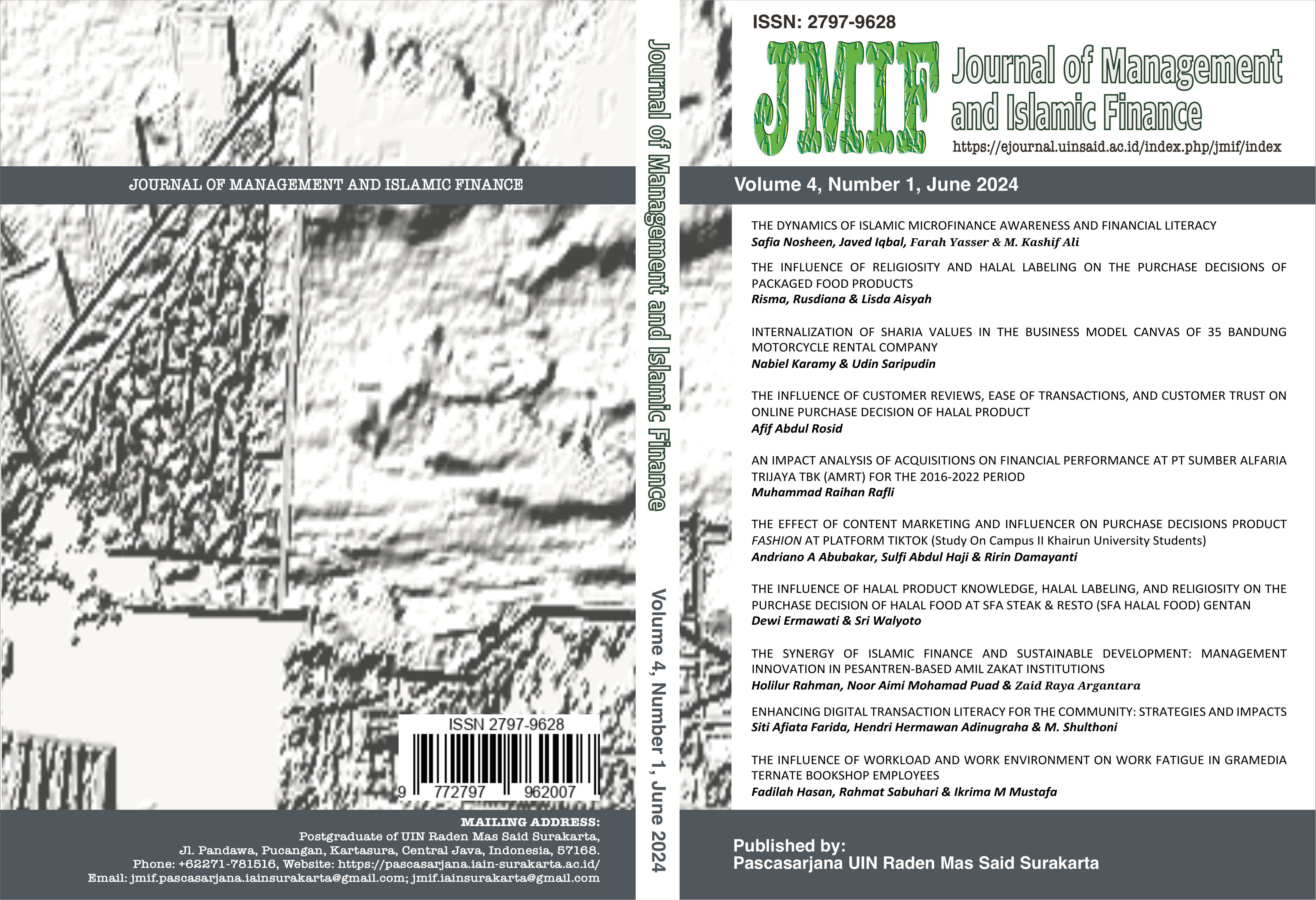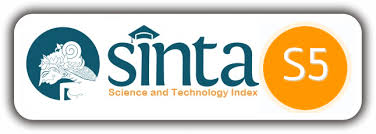THE DYNAMICS OF ISLAMIC MICROFINANCE AWARENESS AND FINANCIAL LITERACY
DOI:
https://doi.org/10.22515/jmif.v4i1.9341Keywords:
Customer Access, Financial Literacy, Islamic Microfinance Awareness, Islamic Microfinance Products, Trust, Financial InstitutionAbstract
This study seeks to bridge the existing gap in the literature, offering a comprehensive analysis of the relationships among Islamic Microfinance Awareness, Financial Literacy, Trust in Financial Institutions, and Customer Access to Islamic Microfinance Products. Small enterprises have been targeted as a sample of Lahore city, Pakistan's second-largest city in terms of population and economic significance. The data is gathered through questionnaires and 256 responses collected from employees across diverse organizations, reinforcing the study's credibility. Partial Least Squares Structural Equation Modelling (PLS-SEM) used to achieve research goals. The study's results align with all the specified hypotheses, confirming the proposed relationships and shedding light on the interconnected dynamics between Islamic Microfinance Awareness, Financial Literacy, Trust in Financial Institutions, and Customer Access to Islamic Microfinance Products. This study investigates the lesser-known aspect of Islamic Microfinance Awareness, providing insights into its influence on consumer access and trust. The practical implications are outlined, proposing that policymakers and financial institutions implement targeted awareness campaigns and financial education initiatives. The research culminates in valuable recommendations for relevant parties, emphasizing the significance of establishing the confidence to promote increased consumer involvement with Islamic Microfinance offerings.
Downloads
References
Ahmad, Z. A., & Rusdianto. (2020). Impact of Transparency and Accountability on Trust and Intention to Donate Cash Waqf in Islamic Microfinance Institutions. Shirkah, 5(2), 197–227.
Akbar, T., & Nabiha, A. . S. (2019). Performance of Islamic Microfinance Banks: The Case of a Developing Country. KnE Social Sciences, 268–288. https://doi.org/10.18502/kss.v3i22.5056
Albaity, M., & Rahman, M. (2019). The intention to use Islamic banking: an exploratory study to measure Islamic financial literacy. International Journal of Emerging Markets, 14(5), 988–1012. https://doi.org/10.1108/IJOEM-05-2018-0218
Ali, S. N. (2011). Shari’a Compliant Microfinance. Routledge.
Allen, F., & Gale, D. (1999). Innovations in financial services, relationships, and risk sharing. Management Science, 45(9), 1239–1253. https://doi.org/10.1287/mnsc.45.9.1239
Bayou, M. E., Reinstein, A., & Williams, P. F. (2011). To tell the truth: A discussion of issues concerning truth and ethics in accounting. Accounting, Organizations and Society, 36(2), 109–124. https://doi.org/10.1016/j.aos.2011.02.001
Billah, M. M. (2021). Benchmarking Islamic Finance A Framework for Evaluating Financial Products and Services. In Routledge (Ed.), Subjects Area Studies, Economics, Finance, Business & Industry.
Braunstein, S., & Welch, C. (2002). Financial Literacy: An Overview of Practice, Research, and Policy. Federal Reserve Bulletin, 88(11), 0–0. https://doi.org/10.17016/bulletin.2002.88-11
Chiu, Y., & Iris, H. (2016). Fintech and Disruptive Business Models in. Journal of Technology Law & Policy, 21(1), 55–112.
Cuevas, C. E., & Fischer, K. P. (2006). Cooperative Financial Institutions. In World Bank Publications (Vol. 82, Issue Issues in Governance, Regulation, and Supervision).
Farrar, S., & Uddin, T. (2020). Building Islamic Ethics into Development: Exploring the Role and Limitations of “Islamic” Microfinance in Poverty Alleviation—An Indonesian Case Study. Journal Law and Development Review, 13(2), 371–406.
Gallardo, J., Goldberg, M., & Randhawa, B. (2006). Strategic alliances to scale up financial services in rural areas. In World Bank Working Paper (Issue 76).
Gannon, B., & Roberts, J. (2020). Social capital: exploring the theory and empirical divide. Empirical Economics, 58(3), 899–919. https://doi.org/10.1007/s00181-018-1556-y
Gim, G. C. W., & Ramayah, T. (2020). Predicting turnover intention among auditors: Is WIPL a mediator? Service Industries Journal, 40(9–10), 726–752. https://doi.org/10.1080/02642069.2019.1606214
Goyal, K., & Kumar, S. (2021). Financial literacy: A systematic review and bibliometric analysis. International Journal of Consumer Studies, 45(1), 80–105. https://doi.org/10.1111/ijcs.12605
Hair, J. F., Hult, G. T. M., Ringle, C. M., & Sarstedt, M. (2021). Book Partial Least Squares Structural Equation Modeling (PLS-SEM) Using R. Springer Nature. https://doi.org/10.1007/978-3-030-80519-7
Hassan, S., Rahman, R. A., Bakar, N. A., Mohd, R., & Muhammad, A. D. (2013). Designing islamic microfinance products for islamic banks in Malaysia. Middle East Journal of Scientific Research, 17(3), 359–366. https://doi.org/10.5829/idosi.mejsr.2013.17.03.12160
Hayat, U., & Malik, A. (2014). Islamic Finance: Ethics, Concepts, Practice. In Islamic Finance: Ethics, Concepts, Practice. https://doi.org/10.2470/rflr.v9.n3.1
Kanwal, A., Tayyab, M., & Idrees, S. (2023). Exploring the Nexus of Financial Technologies, Financial Inclusion, and Blockchain in Islamic Finance within Digital Transformation. Pakistan Journal of Humanities and Social Sciences, 11(4), 4055–4069. https://doi.org/10.52131/pjhss.2023.1104.0674
Kersting, L., Marley, R., & Mellon, M. (2015). The association between financial literacy and trust in financial markets among novice nonprofessional investors. Academy of Accounting and Financial Studies Journal, 19(3), 201.
Khamis, F. M. (2021). Constructing Indicators For Islamic Financial Inclusion. International Journal of Islamic Economics, 3(2), 101. https://doi.org/10.32332/ijie.v3i2.3720
Khan, M. A. (2022). Islamic Economic System–A way forward to address Poverty and achieve Sustainability A Case Study on Islamic Microfinance.
Kovács, L., & Terták, E. (2019). Financial Literacy: Theory and Evidence. Bratislava, Szlovákia: Verlag Dashöfer, 150.
Lai, M. H. C. (2021). Composite reliability of multilevel data: It’s about observed scores and construct meanings. Psychological Methods, 26(1), 90–102.
Lusardi, A., & Mitchell, O. S. (2013). The economic importance of financial literacy. In Journal of Economic Literature (Vol. 52, Issue 1).
Lusardi, A., & Mitchell, O. S. (2014). The economic importance of financial literacy: Theory and evidence. Journal of Economic Literature, 52(1), 5–44. https://doi.org/10.1257/jel.52.1.5
Manzoor, Q.-A. (2011). Impact of Employees Motivation on Organizational Effectiveness. Business Management and Strategy, 3(3), 36–45. https://doi.org/10.5296/bms.v3i1.904
Maulana, H., Razak, D. A., & Adeyemi, A. A. (2018). Factors influencing behaviour to participate in Islamic microfinance. International Journal of Islamic and Middle Eastern Finance and Management, 11(1), 109–130. https://doi.org/10.1108/IMEFM-05-2017-0134
McAllister, D. J. (1995). Affect- and Cognition-Based Trust as Foundations for Interpersonal Cooperation in Organizations. Academy of Management Journal, 38(1), 24–59. https://doi.org/10.5465/256727
Musavengane, R., & Kloppers, R. (2020). Social capital: An investment towards community resilience in the collaborative natural resources management of community-based tourism schemes. Tourism Management Perspectives, 34(February), 100654. https://doi.org/10.1016/j.tmp.2020.100654
Nabi, G., Islam, A., Bakar, R., & Nabi, R. (2017). Islamic microfinance as a tool of financial inclusion in Bangladesh. Journal of Islamic Economics, Banking and Finance, 13(1), 24–51. https://doi.org/10.12816/0051154
Nabi, M., & Aima, A. (2012). Availability And Awareness Of Microfinance In Jammu & Kashmir State. International Journal of Research in Commerce, Economics and Management.
Naveed, M., Farah, M. F., & Hasni, M. J. S. (2021). The transformative role of firm information transparency in triggering retail investor’s perceived financial well-being. International Journal of Bank Marketing, 39(7), 1091–1113.
Obaidullah, M., & Khan, T. (2011). Islamic Microfinance Development: Challenges and Initiatives. In SSRN Electronic Journal (Issue 2). https://doi.org/10.2139/ssrn.1506073
Ozili, P. K. (2021). Financial inclusion research around the world: A review. Forum for Social Economics, 50(4), 457–479. https://doi.org/10.1080/07360932.2020.1715238
Purwanto, P., Abdullah, I., Ghofur, A., Abdullah, S., & Elizabeth, M. Z. (2022). Adoption of Islamic microfinance in Indonesia an empirical investigation: an extension of the theory of planned behaviour. Cogent Business and Management, 9(1). https://doi.org/10.1080/23311975.2022.2087466
Rafiki, A., Nasution, M. D. T. P., Rossanty, Y., & Sari, P. B. (2023). Organizational learning, entrepreneurial orientation and personal values towards SMEs’ growth in Indonesia. Journal of Science and Technology Policy Management, 14(1), 181–212.
Rahim, S. H. A., Rashid, R. A., & Hamed, A. B. (2016). Islamic financial literacy and its determinants among university students: An exploratory factor analysis. International Journal of Economics and Financial Issues, 6(7Special Issue).
Rhyne, E. (2001). Mainstreaming Microfinance: How Lending to the Poor Began, Grew, and Came of Age in Bolivia.
Rohman, P. S., Fianto, B. A., Ali Shah, S. A., Kayani, U. N., Suprayogi, N., & Supriani, I. (2021). A review on literature of Islamic microfinance from 2010-2020: lesson for practitioners and future directions. Heliyon, 7(12), 1–11. https://doi.org/10.1016/j.heliyon.2021.e08549
Safieddine, A. (2009). Islamic financial institutions and corporate governance: New insights for agency theory. Corporate Governance: An International Review, 17(2), 142–158. https://doi.org/10.1111/j.1467-8683.2009.00729.x
Sagiyeva, L. A. K. R., & Shirazi, N. S. (2021). Islamic social finance: a literature review and future research directions. Journal of Islamic Accounting and Business Research, 12(5), 707–728.
Saifurrahman, A., & Kassim, S. (2021). Islamic Financial Literacy for Indonesian MSMEs during COVID-19 Pandemic: Issues and Importance. Journal of Islamic Finance, 10(1), 45–60.
Shinkafi, A. A., & Ali, N. A. (2018). Entrepreneurship development in Islamic economics. In New Developments in Islamic Economics: Examples from Southeast Asia (pp. 3–18). https://doi.org/10.1108/978-1-78756-283-720181001
Shrestha, N. (2021). Factor Analysis as a Tool for Survey Analysis. American Journal of Applied Mathematics and Statistics, 9(1), 4–11. https://doi.org/10.12691/ajams-9-1-2
Tabrani, M., Amin, M., & Nizam, A. (2018). Trust, commitment, customer intimacy and customer loyalty in Islamic banking relationships. International Journal of Bank Marketing, 36(5), 823–848. https://doi.org/10.1108/IJBM-03-2017-0054
Tamanni, L., & Haji Besar, M. H. A. (2019). Profitability vs Poverty alleviation: has banking logic influences Islamic microfinance institutions? Asian Journal of Accounting Research, 4(2), 260–279. https://doi.org/10.1108/AJAR-05-2019-0039
Vivek, S. D., Beatty, S. E., & Morgan, R. M. (2012). Customer engagement: Exploring customer relationships beyond purchase. Journal of Marketing Theory and Practice, 20(2), 122–146. https://doi.org/10.2753/MTP1069-6679200201
Wajdi Dusuki, A. (2008). Banking for the poor: The role of Islamic banking in microfinance initiatives. Humanomics, 24(1), 49–66. https://doi.org/10.1108/08288660810851469
Widdowson, D., & Hailwood, K. (2007). Financial literacy and its role in promoting a sound financial system. Reserve Bank Of New Zealand, 70(2), 37–47.
Yakubu, S. M., Mohammed, A. M. A. A. I., Musa, S. A., & Bello, H. H. S. J. M. (2021). Private Sector Preference for Professional Accountants in Nigeria. Journal of Accounting Finance and Auditing Studies (JAFAS), 7(3), 208–225. https://doi.org/10.32602/jafas.2020.026
Zahid, R. M. A., Rafique, S., Khurshid, M., Khan, W., & Ullah, I. (2024). Do Women’s Financial Literacy Accelerate Financial Inclusion? Evidence from Pakistan. Journal of the Knowledge Economy, 15, 4315–4337.
Zhou, W., Tsiga, Z., Li, B., Zheng, S., & Jiang, S. (2018). What influence users’ e-finance continuance intention? The moderating role of trust. Industrial Management and Data Systems, 118(8), 1647–1670. https://doi.org/10.1108/IMDS-12-2017-0602
Downloads
Published
Issue
Section
Citation Check
License
Copyright (c) 2024 Safia Nosheen, Javed Iqbal, Dr.Farah Yasser, M. Kashif Ali

This work is licensed under a Creative Commons Attribution-ShareAlike 4.0 International License.
Authors who publish with this journal agree to the following terms:
- Authors retain copyright and grant the journal right of first publication with the work simultaneously licensed under a Creative Commons Attribution License that allows others to share the work with an acknowledgement of the work's authorship and initial publication in this journal.
- Authors are able to enter into separate, additional contractual arrangements for the non-exclusive distribution of the journal's published version of the work (e.g., post it to an institutional repository or publish it in a book), with an acknowledgement of its initial publication in this journal.
- Authors are permitted and encouraged to post their work online (e.g., in institutional repositories or on their website) prior to and during the submission process, as it can lead to productive exchanges, as well as earlier and greater citation of published work.






